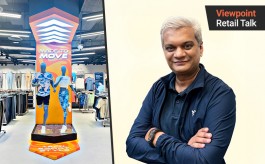‘AI is not a magic wand, but will evolve as a collaborative tool’
By Retail4Growth Team | December 02, 2024
Are retail designers in the loop of how AI is redefining store experience? Has it become integral to the work they do? Sanjay Agarwal, Co-Founder and MD of FRDC and RDI Legion of Honour, addresses these and other questions in this exclusive conversation with Retail4Growth on AI in StoreEx.

The old adage of ‘Customer is King’ might as well be replaced with a new one -Customisation is King! In today’s cluttered environment, personalization is fast emerging to be the key piece when it comes to defining in-store moments and this is where the role of technologies like AI becomes significant.
Driving personalization
As Sanjay Agarwal,Co-Founder and MD at FRDC, and RDI Legion of Honour, says while speaking about the role of AI in retail design and experience, “AI has become a talking point now but it has been in existence for a very long time. What we get to see more commonly is the advancement of AI in its conversational form and there is commercialisation happening around that. But at the front-end customer facing level in retail, personalised engagement is where AI will really make a difference, whether in terms of productrecommendation, experience or just communication.”
So, while AI is already being utilised in back-end functions like inventory management, supply chain or transactions to improve operational efficiency, its role in the front-end /customer facing part, is still being explored, more as an enabler in raising the in-store experiential quotient. And it entails having a strong digital eco system in place. As Sanjay adds, “Without a strong digital ecosystem in place, AI has no meaning.”
Indeed, some of the brands who are constantly refining their customer experience with personalised engagement are those who have a strong digital eco-system in place. These include the likes of Sephora, Starbucks, Nykaa, Adidas, Uniqlo or Zara, who, like their E-commerce counterparts, leverage their digital platforms for customer insights using AI-driven data mapping. It’s just a matter of time before more brands start using these in the brick-and-mortar retail space. As Sanjay says, “I'm sure these will become part of the design experience as AI becomes much more accessible and retailers invest more in creating a digital ecosystem.”
But AI needs thoughtful and strategic use for it to become meaningful while delivering an elevated customer experience. As Sanjay says, “Stores need to incorporate AI in such a way that the customer experience becomessomething wholesome.”
AI as a design tool
So how does AI’s role in front-end retail lead back to the work that store designers do? What role can they play in driving these AI-led customer journeys and how much of disruption is AI really in their scheme of things? Sanjayexplains, while addressing these questions, “We as designers have to be adept at following what's happening in the industry and hand-holdthe partner in terms of making sure the digital touchpoints are a seamless part of the design experience.”
As for AI’s use in the design process, the most commonly practised use of AI tools by retail designers is of course interms of using them for visual suggestions and options, which can be pitched to clients. But Sanjay adds, speaking about this, “Gen AI tools are of course commonly used by designers, but I’d say AI is still at a nascent stageif you look at the design industry as whole and has not yet become mainstream. This is because there are still many aspects that need clarity and streamlining, including issues like copyrights, among others.”
But as Sanjay and many other retail designers point out, using AI tools certainly helps the design team achieve greater efficiency by helping save time that is otherwise spent on visualisation of ideas and concepts. “So regardless of whether you are a retail designer, interior designer, architect, product designer, graphic designer or any other kind of designer, knowing how to use AI tools is a necessary skill today,” points out Sanjay, while highlighting the need for discretion to meet client requirements and ensuring originality of treatment.
He also points to the possibilities that can unfold with AI as a collaborative tool for the design process. “The use of AI will definitely get more structured. Today designers work in isolated processes, whether generating an idea, visualizing it or finding the reference image/colour or materialsand putting them all together. But with AI, this could become much more integrated and happen in one single platform. So, AI will essentially become a collaborative tool, and in a much deeper way.”
But Sanjay is quick to add, while summing up his views on AI, “It's not a magic wand. It’sessentially just a tool which designers will need to train in and incorporate as part of their work routine, just like other software tools that they have been using.”









Comments